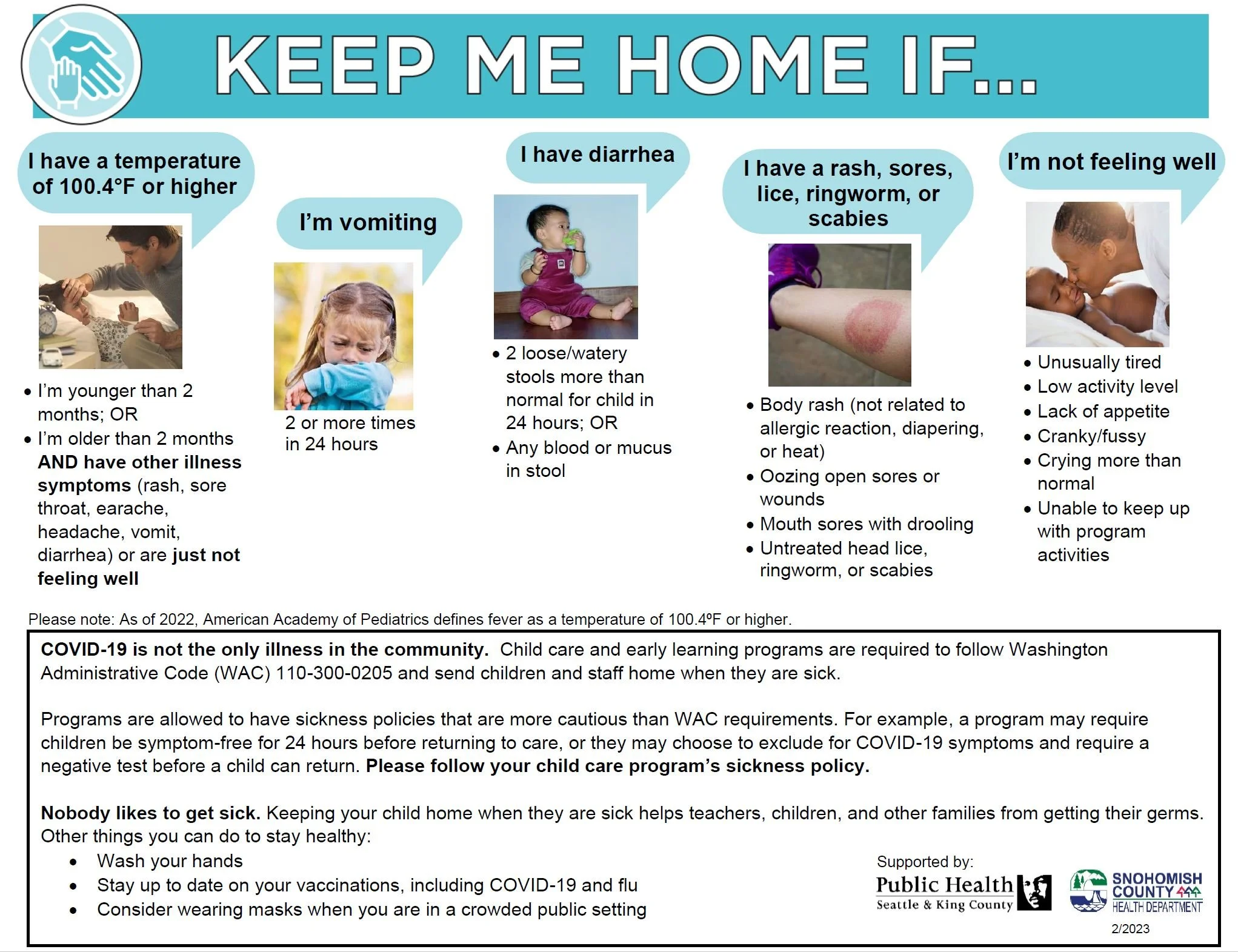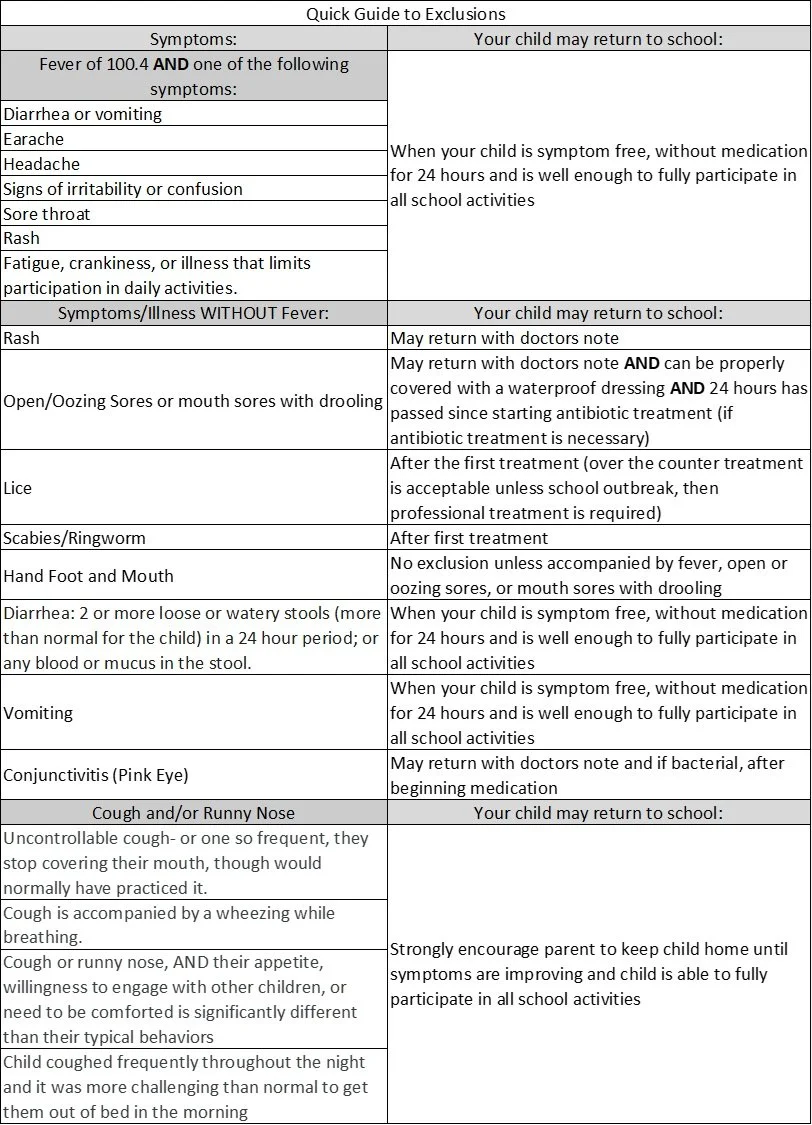Haggard Childcare Resources Illness Policies (Updated 9/2025)
Illness Exclusion. The below reflects HCR’s updated guidance around general illness exclusion policy and return guidance, to supplement public health's "Keep Me Home" graphic. Our goal is to ensure our policy is as clear, predictable, and as rational as we can, while keeping classrooms healthy and happy.
*One caveat: We exclude children after one instance of vomiting if a child shows other indicators of feeling unwell.
Determination and Notification. To support both staff and families, when a classroom identifies the need for a child to be excluded, the determination will go through a Lead Teacher or member of the school leadership. We know the impact this has on families during a busy work day and will do our due diligence before asking a family member or caregiver to pick up their child. We do ask that you trust our assessment and if you have an issue, please bring it to the school Director's attention. Let's help keep each other as healthy as possible!
Quick Guide for Specific Illnesses:
More In-Depth Explanation:
Fever: A fever is defined by the American Academy of Pediatrics as 100.4˚F (38˚C) or above. Methods for taking a temperature may include using a digital forehead scan thermometer (temporal scan) or a digital thermometer placed under the arm (axillary method). We do not take rectal or ear temperatures. A fever, accompanied by one of the following symptoms, will result in exclusion from care:
Diarrhea or vomiting
Earache
Headache
Signs of irritability or confusion
Sore throat
Rash
Fatigue, crankiness, or illness that limits participation in daily activities.
The following symptoms or illness (without a fever) will also be excluded from group care:
Diarrhea: 2 or more loose or watery stools (more than normal for the child) in a 24 hour period; or any blood or mucus in the stool. It is normal for young children to have loose stool occasionally for a variety of reasons. However, Diarrhea, (defined as loose/watery stool and frequent bowel movements) is contagious and can spread rapidly in an early learning environment. Therefore, when a second loose or watery stool is observed by the teacher, the parent will receive a phone call to pick up the child. If the child does not experience more loose/watery stools after pick up they can return at the 24 hour mark. Example: if your child is excluded at 10 am and then has normal bowel movements until 10am the next day they may return at that time.
The only time this exclusion policy does not apply is when there are multiple children experiencing diarrhea symptoms in a particular classroom. In this scenario, you would be informed by the Director at pick up that your child will be excluded for an extended period (up to 72 hours). Some infants and toddlers have ongoing issues with loose stools during the introduction of new foods and may not have solid bowel movements consistently. Please talk with your doctor and provide a note to the center if this is an issue for your child.
Vomiting: If a child vomits at school AND appears fatigued, lethargic or generally unwell they will be excluded for at least 24 hours from the time of the incident. Occasionally a child might vomit due to a circumstance that is not illness related (i.e, exertion, crying, or eating too fast) In this case, the director may allow the child to remain at school and monitor for any additional symptoms.
If a child vomits twice within a 24 hour period they will be excluded immediately and cannot return until they have been symptom free without medication for 24 hours from the last incident.
Example: Your child vomits at school at 9am and again at 6pm on a Monday night. They would not be eligible to return until Wednesday morning if they were symptom free from 6pm on Monday until at least 6pm on Tuesday evening.
Rash: If your child develops a rash while at school that is not (not related to allergic reaction, diapering, or heat) Your Director will ask that you take your child to see a doctor and obtain a note with a diagnosis and a determination as to whether or not the rash is contagious before you may return to care. If your child has eczema and or another recurring skin condition, please provide a note from the doctor to avoid multiple exclusions.
Open or oozing sores or mouth sores with drooling. Open and oozing sores should be diagnosed by a doctor. The school will notify you and ask that you see a doctor to determine disease. The child may return with a note when the sores are no longer oozing or can be covered with a waterproof dressing. If the infection requires antibiotic treatment, you may return 24 hours after starting antibiotics. Sores in the mouth can be very painful and children may sometimes resist eating or drinking as a result of the sores. In this case, you may be asked to keep your child home even if drool isn’t present.
Hand Foot and Mouth is a very common childhood illness. One of the symptoms is open, oozing sores on the body and in the mouth and may include a fever. You will be asked to get a diagnosis so that we can post a communicable disease notice in the center as HFM is highly contagious and we are required to notify other families of any cases. Please see the exclusion policy above for open oozing sores. HFM follows the same exclusion protocols.
Pink Eye (Conjunctivitis) Conjunctivitis is a common eye infection in young children. It is often called “pink eye” and can be viral or bacterial. Your child’s eyes may appear swollen, red or pink, watery, itchy and/or begin to discharge fluid that is yellow or green. If a teacher observes these symptoms, you will be asked to get a doctor’s note to confirm if the irritation is due to conjunctivitis. If it is bacterial, you will be prescribed antibiotic eye drops and your child can return to school 24 hours after you begin treatment as long as your child is well enough to participate and is fever free. If the conjunctivitis is viral, then you may return to school when their eyes are no longer watery and are clear of discharge.
Lice: Lice is most common at the preschool age level. If your child has lice you will be asked to pick your child up so that it can be treated at home or by a professional. Your child may return to care after they have received their first treatment. However, The life cycle of a louse is about 25 to 30 days, so treatments often need to be repeated 7 to 12 days after the first treatment to kill newly hatching lice. If there is an outbreak of three or more cases within a two week period in a single classroom, the director may ask you to have your child treated by a professional versus with an over the counter treatment and/or have the entire school checked by a lice professional to limit spread. When a single case occurs at school, all the children will be checked by a teacher or administrator to help catch any additional cases early.
Scabies or ringworm: If your child develops a rash that looks like scabies or ringworm while at school. Your Director will ask that you take your child to see a doctor and obtain a note with a diagnosis and a determination as to whether or not the rash is contagious before returning to care. If your child has eczema and or another recurring skin condition, please provide a note from the doctor to avoid multiple exclusions.
A child with scabies/ringworm may return after he/she has received his/her first treatment. Children should see their health care provider to be assessed at the onset of symptoms so that they get an appropriate prescription for treatment. They may return if the ringworm can be covered adequately and they have no other symptoms.

